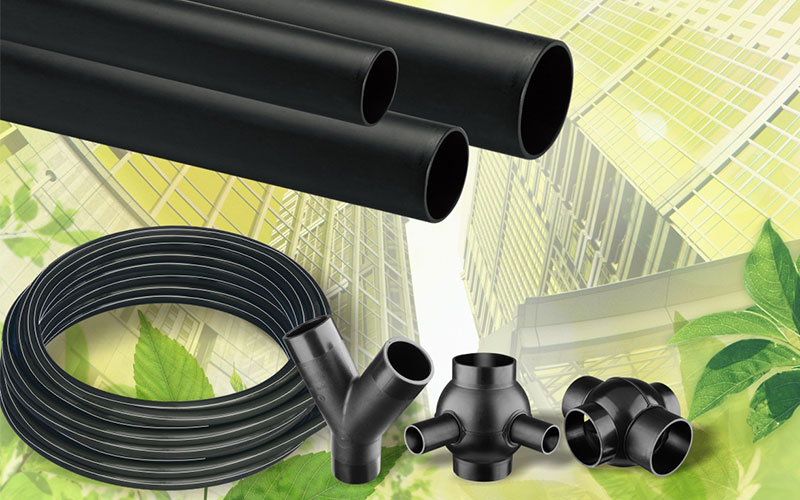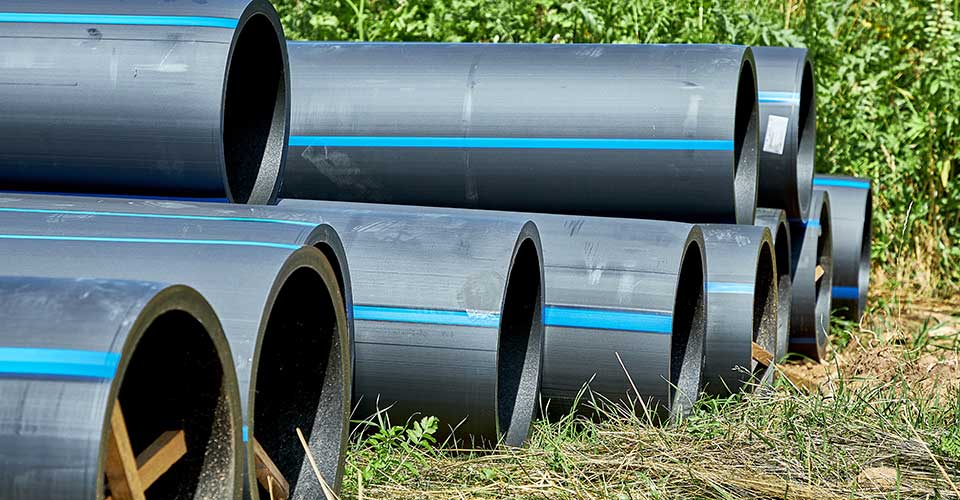How Midland TX HDPE Pipe Fittings in Stock Save Time
Wiki Article
The Crucial Actions for Successful Setup of HDPE Pipe in Your Next Project
Successful installation of HDPE pipeline needs cautious planning and execution. Secret steps consist of evaluating project demands, preparing the site, and picking correct joining strategies. Each phase plays a vital duty in ensuring the honesty and efficiency of the pipeline. Understanding these vital steps can greatly affect the general success of the job - Pipe Supplier American Plastics Midland. The nuances of each step might hold the secret to getting over common obstacles encountered during setup.Understanding the Perks of HDPE Pipeline
High-density polyethylene (HDPE) pipe supplies various benefits that make it a preferred option for numerous applications. Its high resistance to corrosion and chemicals warranties toughness sought after atmospheres, significantly prolonging the life-span of installations. Furthermore, HDPE's versatility enables simpler setup, specifically in challenging terrains, as it can bend without breaking. The lightweight nature of HDPE pipe streamlines transport and handling, lowering labor costs during installation.Additionally, HDPE pipeline is recognized for its reduced rubbing coefficient, which improves fluid circulation and decreases power intake. Its seamless building decreases the threat of leakages, adding to much better resource administration and environmental protection. On top of that, HDPE is recyclable, lining up with lasting methods and minimizing ecological influence. Overall, the mix of toughness, adaptability, and eco-friendliness makes HDPE pipeline a superior selection for a large variety of jobs, from water distribution to industrial applications.
Planning Your HDPE Pipeline Installment
When preparing a setup of HDPE pipe, cautious consideration of a number of essential aspects is essential to secure an effective project. First, project managers have to evaluate the certain demands of the pipeline, consisting of the intended usage, circulation rates, and ecological problems. Recognizing these parameters will certainly lead the selection of suitable pipeline dimensions and material grade.Next, timelines should be established, considering procurement timetables and any kind of prospective delays. Coordination with neighborhood authorities for permits and regulatory conformity is likewise crucial. In addition, an in-depth spending plan must be prepared, incorporating all prices connected with products, labor, and machinery.
Last but not least, it is crucial to involve a qualified group experienced in HDPE pipe installation. Their knowledge will help minimize risks, warranty adherence to market criteria, and inevitably contribute to the job's success. Thorough preparation prepares for a smooth installment procedure and lasting efficiency of the HDPE piping system.
Preparing the Website for Installation
Correct website prep work is necessary for the successful setup of HDPE pipeline. Prior to setup begins, the website has to be completely examined to ensure it fulfills all needed needs. This consists of surveying the ground for existing structures, energies, and potential hazards that can restrain the installment process.

Appropriate elevation and positioning need to be established to maintain a consistent gradient for water drainage functions. Correct drainage around the installation site is additionally critical to stop water accumulation, which can result in difficulties down the line.
Techniques for Signing Up With HDPE Pipings
Accomplishing a reputable link between HDPE pipelines is essential for guaranteeing the stability and durability of the setup. Different techniques exist for signing up with these pipelines, each suited for different task needs. Blend welding is one of the most usual techniques, utilizing warmth to bond the pipe finishes with each other, creating a smooth and resilient link. This method can be additional categorized right into socket blend and butt combination, depending on the pipeline configurations.Mechanical installations are another alternative, utilizing clamps and threaded adapters to join areas of HDPE pipeline. While typically faster to mount, they may call for additional upkeep over time. Electrofusion is a specific technique that involves utilizing electric existing to warm and fuse the pipelines through specifically designed fittings, making certain a strong bond. Choosing the proper signing up with technique is critical, as it directly influences the total efficiency and dependability of the HDPE piping system in the intended application.
Examining and Inspection of Installed Pipes
The screening and evaluation of set up HDPE pipelines are critical to guaranteeing their performance and longevity. This procedure incorporates aesthetic examination techniques, stress screening approaches, and leakage discovery treatments to determine prospective problems. By utilizing these techniques, experts can verify the honesty of the installation prior to it is placed right into usage.Aesthetic Inspection Techniques
Employing effective visual inspection techniques is vital for assuring the honesty of mounted HDPE pipelines. Examiners ought to systematically analyze all noticeable sections of the pipe to determine any type of indications of damage, misalignment, or inappropriate setup. Key indications to evaluate consist of joint stability, surface irregularities, and links. Assessors might use tools such as multiplying glasses or electronic cameras to boost exposure and detail. It is important to check for indicators of environmental anxiety, such as buckling or too much bending, which might jeopardize performance. Consistent documentation of searchings for enables for tracking adjustments gradually and helps overview necessary repairs. By sticking to well established visual assessment protocols, job teams check here can significantly reduce the threat of future failures and ensure lasting reliability of the piping system.Stress Testing Techniques
Visual assessment serves as an initial step, yet it is not adequate on its own to ensure the efficiency of installed HDPE pipelines. Pressure screening methods are essential for making certain the integrity of these systems. Normally, hydrostatic testing is used, where the pipelines are loaded with water and based on stress levels above the desired operating pressure. This approach helps determine weak points or potential leaks. Pneumatically-driven screening can also be used, although it brings higher dangers due to the compressibility of air. Regardless of the approach chosen, adhering to market requirements and safety and security protocols is important. After conducting pressure examinations, extensive paperwork is needed to confirm the outcomes and verify that the setup satisfies all operational demands before proceeding to the next stage of the project.
Leak Discovery Procedures
How can one guarantee that mounted HDPE pipelines are devoid of leaks? Reliable leakage detection procedures are essential to protect the stability of the system. Initially, aesthetic inspections need to be done, searching for signs of water buildup or soil disintegration around pipeline joints. Following this, pressure testing can validate the system's toughness. A typical approach is the hydrostatic test, where water is presented under pressure, monitoring for decreases that indicate possible leaks. Furthermore, progressed innovations, such as acoustic sensing units or infrared thermography, can identify leaks that might not show up. Normal monitoring and upkeep more contribute to the durability of HDPE pipes, ensuring they stay leak-free throughout their functional life-span. Appropriate documentation of these procedures is essential for compliance and future recommendation.Upkeep Tips for Long-Term Performance
To ensure the long life of HDPE pipes, establishing a routine inspection routine is essential. This proactive technique enables the early discovery of potential problems, decreasing pricey repairs. Furthermore, carrying out correct cleaning techniques will assist preserve peak efficiency and stop build-up that can influence functionality.Regular Evaluation Schedule
HDPE pipes are known for their resilience and resistance to corrosion, developing a routine examination timetable is necessary for guaranteeing their long-lasting performance. Regular evaluations help identify possible concerns such as leakages, joint stability, and environmental effects that may affect the pipeline's capability. It is suggested that evaluations take place at the very least biannually, or more often in environments with severe conditions. hdpe pipe suppliers Midland TX. Throughout these assessments, visual checks need to be conducted to detect indications of wear or damages. In addition, using innovation such as ultrasonic screening can give more insights right into the pipe's condition. By carrying out a structured evaluation timetable, task supervisors can proactively address problems, thereby expanding the life expectancy of HDPE pipelines and preserving system efficiencyAppropriate Cleansing Techniques
Proper cleaning strategies play a crucial duty in maintaining the long-lasting performance of HDPE pipelines. Routine cleaning stops the accumulation of particles, sediment, and biofilm, which can bring about blockages and reduced circulation effectiveness. Operators should use methods such as high-pressure water jetting or foam cleaning to efficiently remove impurities without harming the pipe surface. It is crucial to prevent utilizing severe chemicals that may weaken HDPE material. In addition, set up maintenance checks need to include aesthetic evaluations for any type of signs of wear or damage. Effectively trained workers should accomplish these cleansing procedures, ensuring compliance with safety and environmental laws. By executing these techniques, the life expectancy of HDPE pipes can be considerably extended, making certain ideal performance throughout their functional life.Frequently Asked Questions
What Are the Ecological Effects of HDPE Pipeline Production?
The ecological influences of HDPE pipe production include greenhouse gas exhausts, power usage throughout production, potential plastic pollution, and difficulties in recycling. HDPE's long life and resistance to rust can alleviate some ecological concerns.Just How Does HDPE Pipeline Contrast to Other Materials?

What Equipment Are Required for HDPE Pipeline Installation?
Essential tools for HDPE pipeline installment consist of a blend machine, pipeline cutters, shovels, measuring tape, and security equipment. Correct tools guarantees efficient, secure handling and installation, adding to the task's total success and stability.Are There Any Particular Rules for HDPE Pipeline Installation?
Details laws for HDPE pipeline installment differ by region, typically controlled by neighborhood, state, or government codes. Conformity with these guidelines guarantees safety and security, ecological defense, and capability, making adherence crucial for effective project outcomes.Can HDPE Pipes Be Recycled After Usage?
Yes, HDPE pipelines can be recycled after use. Their thermoplastic nature permits reprocessing, making them ideal for reusing into new products. This sustainability facet adds to environmental conservation and promotes round economic situation techniques in building and construction.Report this wiki page